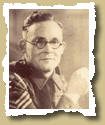 |
George Frederick Weightman
Sergeant -
56th Brigade - 50th Infantry Division
|
I was born on the 13th October
1909 in Leicester and I joined the Territorial Army in 1939.
When the war was declared I joined a searchlight unit and was trained
as a Bofors gunner. I rose to the rank of Sergeant and served in
England and Scotland on the coastal defences at the beginning of
the war.
I was stationed at Hastings in the south of England when I received
orders to join the 56th Infantry Brigade early in 1944. First I
went to Scotland on a waterproofing course. This was to ensure that
the vehicles used in the invasion would be reliable when landing
in the sea on invasion day.
In early May the invasion
force was being built up together in Southern England. I was the
stationed in the NewForest, which was ideal camouflage for all the
weaponry to be used on invasion day.
I was then ordered to Southampton to await with thousands of other
English soldiers for the start of D-Day.
We stayed on the streets of Southampton for 5 - 6 days. Local people
helped with cups of tea and sandwiches from their meagre rations.
We then boarded at Southampton
a L.C.T., a Landing Craft Tank. Big enough to take men and armour
across the Channel. The L.C.T. then moved out into the Channel to
a position where all the invasion fleet was to gather. We remained,
on board in all 4 - 5 days knowing nothing and doing nothing.
The first day designated for Harding was June 5th but due to bad
weather this was cancelled. But at night later on June 5th the fleet
had a message from General Eisenhower, it said: "Let's go boys".
Anchors were up and during night + early hours of June 6th we crossed
the Channel.
I embarked from the L.C.T. on to a Rhino, a big landing craft, about
1 mile from the shore. I went in on the second wave to Gold Beach
where the first wave had secured a hole.
We were strafed by German planes, bombarded by coastal batteries
and harassed by German snipers.
My regiment reformed near
Bayeux, after landing and going forward. We fought at Bayeux, Tilly
sur Seulles. Big battles were fought before breaking out.
From Tilly we fought at Villers Bocage, a big battle and many men,
both sides, fell.
Then on to Saint-Lô, another battle where the English met
up with the Americans. We fought there for 2 days. Then to Falaise,
where the Germans were trapped by encircling, Americans, English,
Canadians and Free French, this was the battle of Falaise gap. The
Germans suffered a mighty defeat. Next was Le Havre were the German
garrison fought but in the end surrendered.
After being in action for
some time, I was rested for 4 - 5 days near St Romaire.
The back to battle pushing the Bosch back to Germany.
George Frederick Weightman (November 11, 2003)
|

